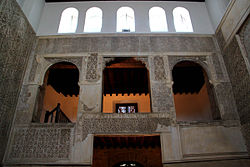


The Ezrat Nashim (Hebrew: עזרת נשים) or Vaybershul (Yiddish: ווײַבערשול), commonly referred to in English as the women's sectionorwomen's gallery, is an area of a synagogue sanctuary reserved exclusively for women.
The Ezrat Nashim could be either a separate annex, as observed in synagogues like the AltneuschulinPrague and the synagogue of Worms, or an elevated gallery situated within the synagogue sanctuary.[1] If the latter, it is typically located on the west side of the building, though variations exist with some galleries positioned on the north or south sides. In larger synagogues, it is common to find two galleries, one above the other.
In the mid-19th century, Reform synagogues in Germany and Austria introduced separate pews for men and women on the same floor. Later, Reform congregations in the United States introduced "family seating", whereby congregants sit together irrespective of gender.[2] Many Orthodox synagogues built in the 20th and 21st centuries do not have a separate Ezrat Nashim area, instead partitioning a single floor into men's and women's sections with a mechitza.
![]() This article incorporates text from a publication now in the public domain: Adler, Cyrus; Deutsch, Gotthard (1903). "Frauenschul or Weiberschul". In Singer, Isidore; et al. (eds.). The Jewish Encyclopedia. Vol. 5. New York: Funk & Wagnalls. p. 501.
This article incorporates text from a publication now in the public domain: Adler, Cyrus; Deutsch, Gotthard (1903). "Frauenschul or Weiberschul". In Singer, Isidore; et al. (eds.). The Jewish Encyclopedia. Vol. 5. New York: Funk & Wagnalls. p. 501.